In the dynamic world of web development, where frameworks and technologies constantly evolve, Ruby on Rails has emerged as a robust and elegant solution for building web applications. This open-source framework, commonly referred to as Rails or RoR, is written in Ruby, a dynamic, object-oriented programming language known for its simplicity and productivity. Ruby on Rails follows the convention over configuration (CoC) and don’t repeat yourself (DRY) principles, streamlining the development process and allowing developers to focus on solving business problems rather than dealing with tedious configurations.
What is Ruby?
Ruby is a dynamic, object-oriented programming language designed for simplicity and productivity. It was created by Yukihiro Matsumoto and first released in 1995. Ruby emphasizes readability and ease of use, making it a popular choice for web development and other applications.
What is Ruby development ?
Ruby development refers to the process of creating software applications using the Ruby programming language. Ruby is a dynamic, object-oriented programming language designed for simplicity and productivity. Here’s a brief overview of Ruby development:
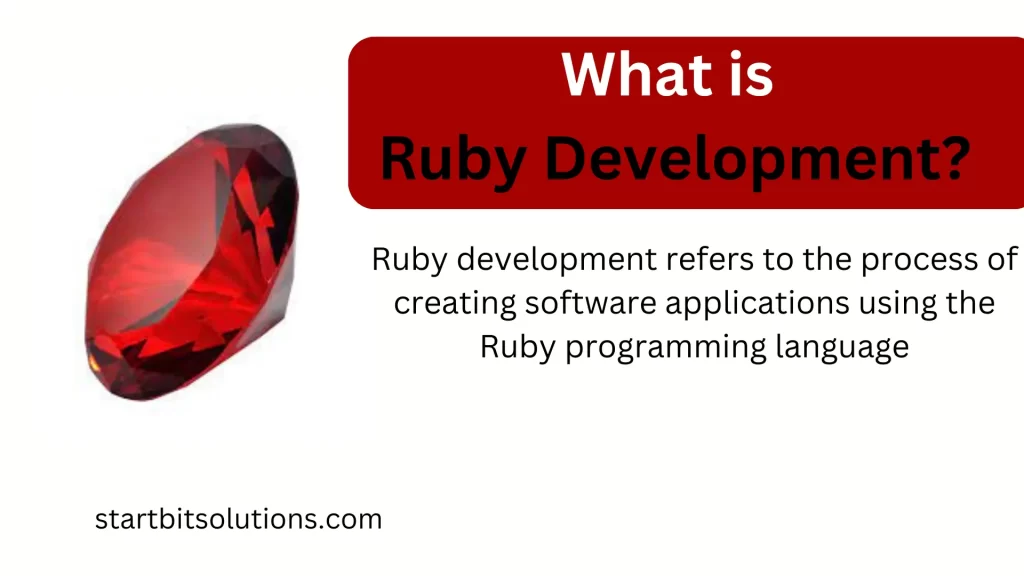
Key Features of Ruby Development:
- Syntax Simplicity: Ruby is renowned for its elegant and easy-to-read syntax. It emphasizes readability and minimizes the use of symbols, making it a great choice for both beginners and experienced developers.
- Object-Oriented: Everything in Ruby is an object, which means it follows the principles of object-oriented programming (OOP). This approach allows developers to organize code in a modular and reusable way.
- Dynamic Typing: Ruby is dynamically typed, meaning you don’t need to specify the data type of a variable explicitly. This flexibility simplifies development and speeds up the coding process.
- Gems and Libraries: The Ruby community is vibrant, and developers benefit from an extensive collection of gems (libraries) that can be easily integrated into their projects. This rich ecosystem enhances productivity and accelerates development.
- Rails Framework: Ruby on Rails (RoR) is a popular web application framework written in Ruby. It follows the convention over configuration (CoC) and don’t repeat yourself (DRY) principles, streamlining the development of robust and scalable web applications.
- Community Support: The Ruby community is known for its friendliness and willingness to help. There are numerous online resources, forums, and tutorials available, making it easy for developers to seek assistance and share knowledge.
- Cross-Platform Compatibility: Ruby is a cross-platform language, meaning that Ruby applications can run on various operating systems with minimal modifications. This versatility adds to the language’s appeal for developers working in different environments.
- Testing Frameworks: Ruby has robust testing frameworks like RSpec and MiniTest, encouraging developers to adopt a test-driven development (TDD) approach. This leads to more reliable and maintainable code.
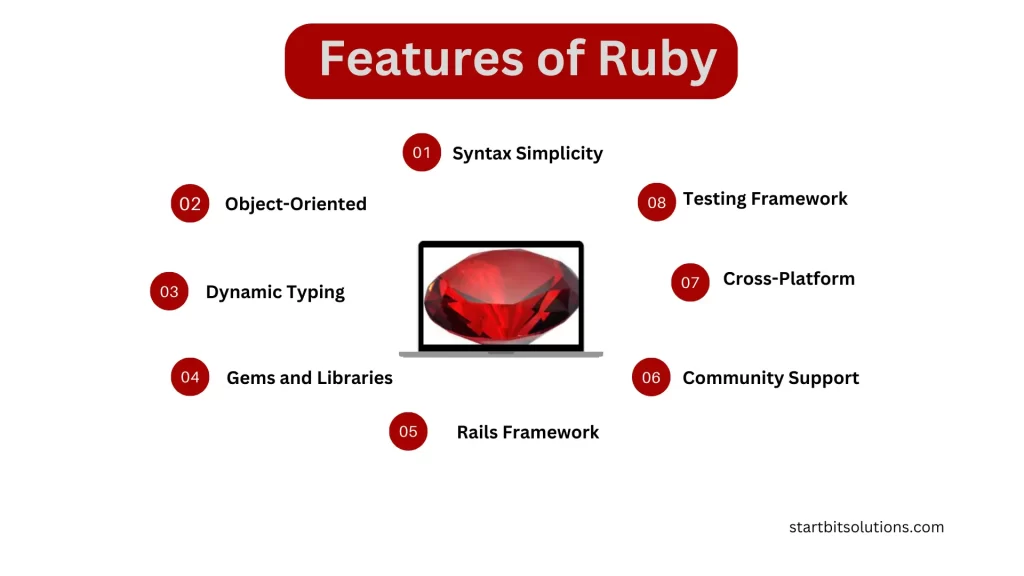
What is ROR ( Ruby on Rails)?
Rails, also known as Ruby on Rails (RoR), is a web application framework written in Ruby. It follows the Model-View-Controller (MVC) design pattern, providing a structured way to build and organize web applications. Rails aims to make web development more straightforward and efficient by emphasizing convention over configuration.

The MVC Architecture:
- Model: Represents the data and business logic of the application.
- View: Deals with the presentation and user interface.
- Controller: Manages the communication between the Model and View, handling user inputs and updating the Model accordingly.
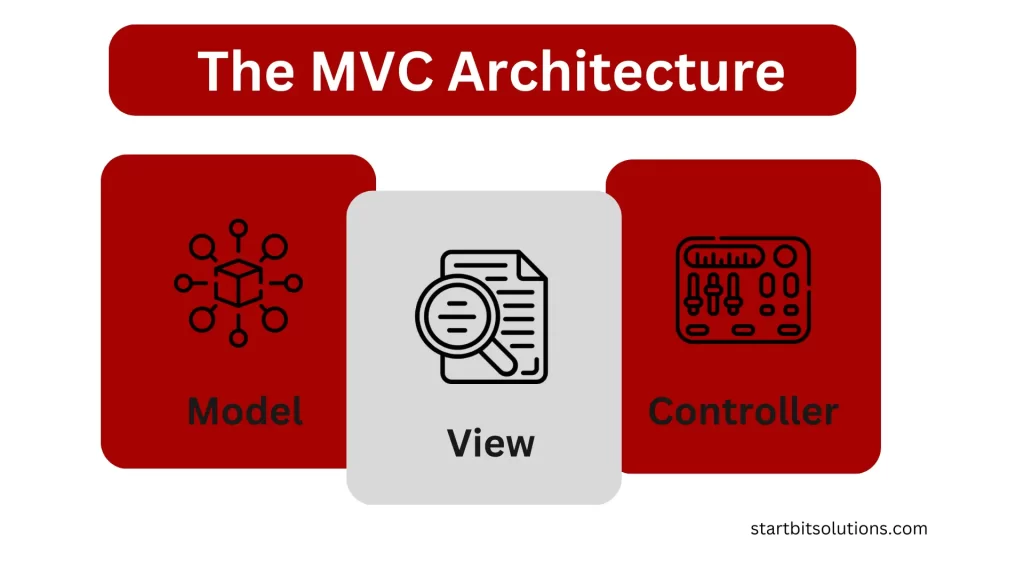
Convention over Configuration: One of Rails’ guiding principles is “Convention over Configuration” (CoC), which means that the framework comes with a set of default conventions. Developers need to specify only the unconventional aspects, reducing the need for repetitive configuration.
Active Record: Rails incorporates Active Record, an Object-Relational Mapping (ORM) system that simplifies database interaction. With Active Record, developers can interact with the database using Ruby instead of SQL queries.
DRY Principle: Rails encourages the “Don’t Repeat Yourself” (DRY) principle, minimizing redundancy in code. Reusable components and conventions help in writing clean, concise, and maintainable code.
Why Choose Rails?
- Rapid Development: Rails’ emphasis on convention and automation allows developers to build robust applications quickly, saving time and effort.
- Community and Resources: Being open-source, Rails has a vast and supportive community. Numerous resources, tutorials, and gems (Ruby libraries) are available, making it easier for developers to find solutions to problems.
- Scalability: Rails is scalable, making it suitable for both small startups and large enterprises. Its modular structure allows developers to add functionalities as the application grows.
- Testing: Rails places a strong emphasis on testing. Developers can easily write and run tests, ensuring the reliability and stability of the codebase.
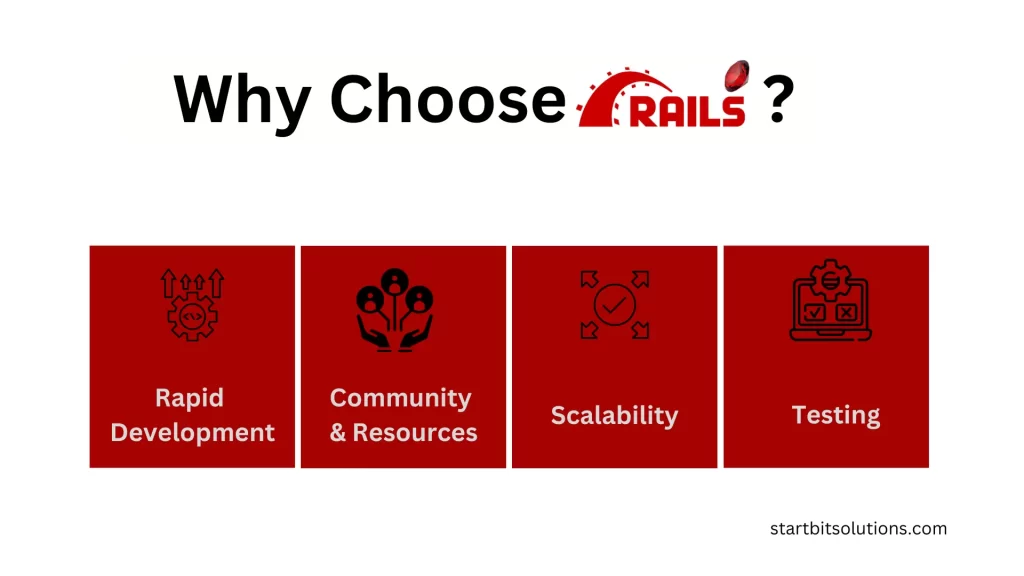
History of Ruby on Rails
Ruby on Rails, commonly known as Rails, has a captivating journey that began in the early 2000s. Let’s take a quick dive into the history of this powerful web application framework.
Birth of Ruby on Rails
2004 – The Brainchild of David Heinemeier Hansson: Rails was created by Danish developer David Heinemeier Hansson. He extracted the framework from a project management tool he was building for his web development firm, 37signals.
2005 – Open-Source Debut: Rails was officially released as an open-source framework in July 2004. This move contributed significantly to its rapid adoption.
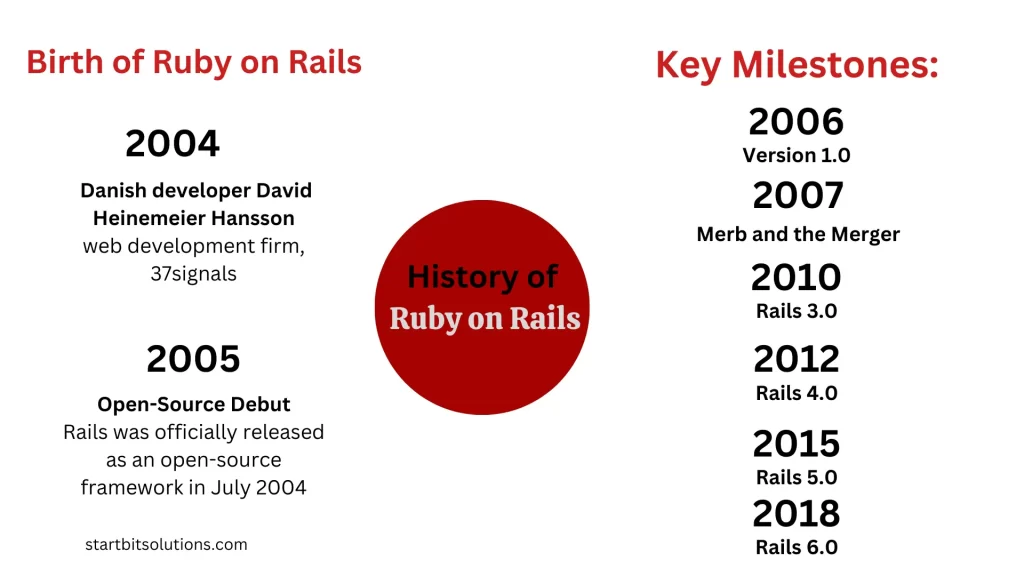
Key Milestones:
- 2006 – Version 1.0: Rails 1.0 was released, marking a stable and feature-rich version that gained widespread attention in the developer community.
- 2007 – Merb and the Merger: Merb, a lightweight web framework, emerged as competition to Rails. However, in 2008, both projects decided to merge, combining strengths to create a more robust framework.
- 2010 – Rails 3.0: Rails 3.0 was a major release, introducing the “Rails Way” philosophy and focusing on modularity and flexibility.
- 2012 – Rails 4.0: This version brought improvements in performance, security, and developer convenience.
- 2015 – Rails 5.0 With the introduction of Action Cable, Rails 5.0 added support for WebSockets, enhancing real-time features in web applications.
- 2018 – Rails 6.0: Rails 6.0 introduced new features like Action Mailbox and Action Text, providing built-in solutions for handling incoming emails and rich text content.
Ruby vs Ruby on Rails
Ruby
Scripting and Automation: If your project involves scripting or automation tasks, leveraging the simplicity and expressiveness of Ruby as a standalone language might be the optimal choice. Ruby’s clean syntax makes it ideal for quick scripts and small utilities.
Versatility in Project Scope: Ruby’s versatility allows it to shine in a multitude of scenarios. If your project spans various domains, and you need a language that adapts to different programming paradigms, Ruby offers the flexibility needed for diverse tasks.
Ruby on Rails
Web Application Development: For web applications with a focus on efficiency and scalability, Ruby on Rails is the go-to solution. The framework’s conventions and built-in features expedite the development process, making it suitable for projects where time-to-market is crucial.
Embracing MVC Architecture: If your project demands a well-organized and maintainable codebase, the MVC architecture enforced by Rails provides a structured approach. This is particularly beneficial for large-scale applications with complex functionalities.
Key Features of Ruby on Rails Framework
Dynamic Data Magic (DDM) is a groundbreaking feature in Ruby on Rails that revolutionizes the way developers handle and manipulate data in their applications. Unlike traditional approaches where data is static and unyielding, DDM introduces a dynamic layer that empowers developers to perform magical transformations on their data effortlessly.
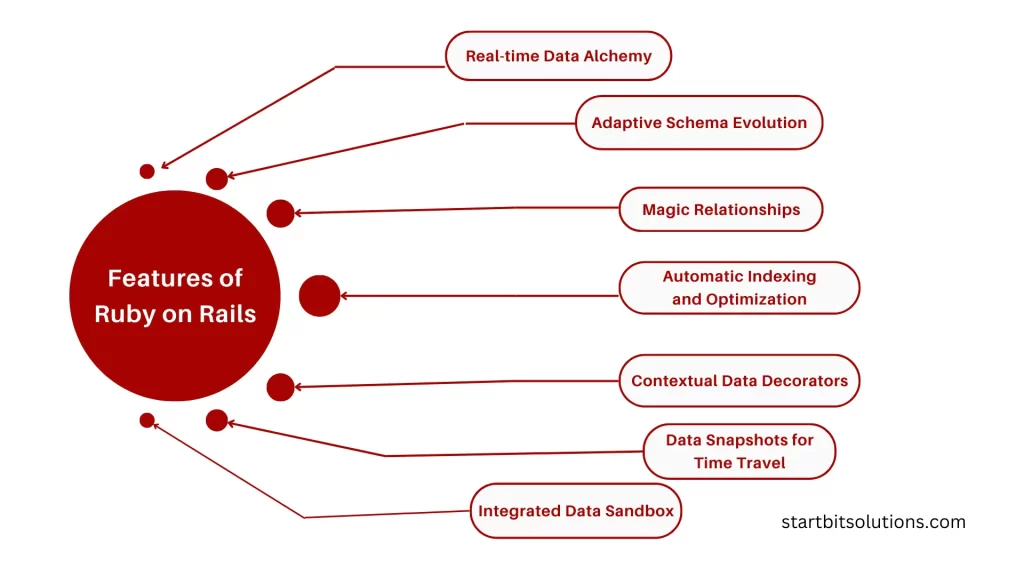
- Real-time Data Alchemy: DDM allows developers to perform real-time transformations on data at the database level. Imagine being able to change the data structure on the fly without altering the underlying database schema. This means you can seamlessly add, remove, or modify attributes without the need for migrations. It’s like practicing data alchemy in real time!
- Adaptive Schema Evolution: With DDM, the application’s data schema evolves dynamically based on the changing needs of the application. No more rigid database structures that resist change. Developers can adapt the schema according to the evolving requirements, ensuring a more flexible and agile development process.
- Magic Relationships: DDM introduces the concept of “Magic Relationships,” where associations between different models can be created and modified dynamically. This means you can establish connections between models without the need for predefined associations in the code. This dynamic relationship management simplifies the handling of complex data dependencies.
- Automatic Indexing and Optimization: DDM intelligently analyzes query patterns and optimizes database indexes automatically. It ensures that your application’s performance is maximized without the need for manual intervention. As your data access patterns change, DDM adapts the indexing strategy accordingly, providing optimal query performance.
- Contextual Data Decorators: Developers can apply contextual data decorators to transform the appearance of data based on the context in which it’s presented. This feature is particularly useful for displaying data in various parts of a user interface, allowing for a personalized and context-aware user experience without modifying the core data structure.
- Data Snapshots for Time Travel: DDM introduces the ability to capture and store data snapshots at different points in time. This feature enables developers to “time travel” through the application’s data history, making it easier to analyze changes, track issues, and implement versioning without complex version control systems.
- Integrated Data Sandbox: DDM comes with an integrated data sandbox for experimenting with data transformations and testing new ideas. Developers can safely play with data changes in a controlled environment before applying them to the production database, reducing the risk of unintended consequences.
What is Ruby on Rails Used for?
Ruby on Rails, often simply referred to as Rails, is a powerful and versatile web application framework that has gained widespread popularity in the software development community. Its flexibility and ease of use make it a preferred choice for various types of applications. Here are some key areas where Ruby on Rails is commonly used:

- Web Application Development: Ruby on Rails is primarily designed for building web applications. It provides a robust structure and conventions that streamline the development process, allowing developers to focus on building features rather than dealing with repetitive tasks. Whether it’s a small startup or a large enterprise, Rails can be used to develop scalable and maintainable web applications.
- Content Management Systems (CMS): Many content management systems are built using Ruby on Rails due to its efficiency and ease of customization. Developers can leverage the framework’s modular architecture to create flexible and user-friendly CMS solutions tailored to the specific needs of clients.
- E-commerce Platforms: Ruby on Rails is an excellent choice for developing e-commerce applications and platforms. Its built-in features, combined with a vast ecosystem of Ruby Gems, make it easy to implement secure payment gateways, manage inventory, and create a seamless shopping experience for users.
- Startups and MVPs (Minimum Viable Products): The rapid development capabilities of Ruby on Rails make it ideal for startups looking to quickly launch their products. Its convention-over-configuration principle and the DRY (Don’t Repeat Yourself) philosophy allow developers to prototype and iterate efficiently, making it a popular choice for building minimum-viable products.
- Social Networking Sites: The framework’s scalability and efficient handling of client requests make it suitable for developing large-scale social networking sites. Its convention-based approach simplifies the development of complex features, ensuring a smoother development process for social platforms.
- Financial Technology (FinTech): In the FinTech sector, where security and robustness are crucial, Ruby on Rails provides a solid foundation. Developers can navigate through the complexities of payment services, transactions, and banking solutions while benefiting from the safety and testing capabilities inherent in the framework.
- API (Application Programming Interface) Development: Rails is often used for building APIs, allowing different software components to communicate with each other. The framework’s RESTful architecture and built-in support for JSON make it easy to create scalable and well-documented APIs.
Ruby on Rails is a versatile framework that excels in various domains, from web application development to e-commerce and beyond. Its developer-friendly conventions and strong community support contribute to its widespread adoption in the software development industry.
Why Ruby on Rails?
Choosing Ruby on Rails for web development comes with several advantages that make it a popular choice among developers. Here are some key reasons why Ruby on Rails is often preferred:
- Productivity Boost: Ruby on Rails is known for its developer-friendly nature. It follows the principle of convention over configuration, meaning developers don’t have to spend time on repetitive configurations. This boosts productivity and allows teams to focus on building features rather than dealing with setup details.
- Rapid Development: Rails is designed for speed. Developers can build web applications quickly, making it an excellent choice for startups or projects with tight deadlines. Its code generation features and a vast library of ready-to-use components (Gems) contribute to a fast development process.
- Clean and Readable Code: Ruby, the programming language behind Rails, emphasizes readability and simplicity. This leads to clean and elegant code, making it easier for developers to collaborate, maintain, and understand each other’s work.
- Strong Community Support: Ruby on Rails has a vibrant and supportive community. This means there are plenty of resources, tutorials, and Gems available. Developers can seek help, share knowledge, and contribute to the community, fostering a collaborative environment.
- Scalability: Rails is scalable and can handle the growth of applications over time. Many successful websites, including large-scale platforms like GitHub, Shopify, and Airbnb, have been built using Ruby on Rails. Its modular design and scalability make it suitable for both small projects and massive applications.
- Convention-Over-Configuration: Rails follows a set of conventions that reduces decision fatigue for developers. By sticking to these conventions, developers can work more efficiently as they spend less time making decisions about how things should be structured or named.
- Security Features: Security is a top priority in web development. Ruby on Rails comes with built-in security features, such as protection against common vulnerabilities like SQL injection and Cross-Site Scripting (XSS). This helps developers create secure applications without having to implement everything from scratch.
- Open Source and Cost-Effective: Ruby on Rails is open-source, meaning it’s free to use and developers can modify it according to their needs. This reduces development costs and makes it accessible to a wide range of developers and businesses.
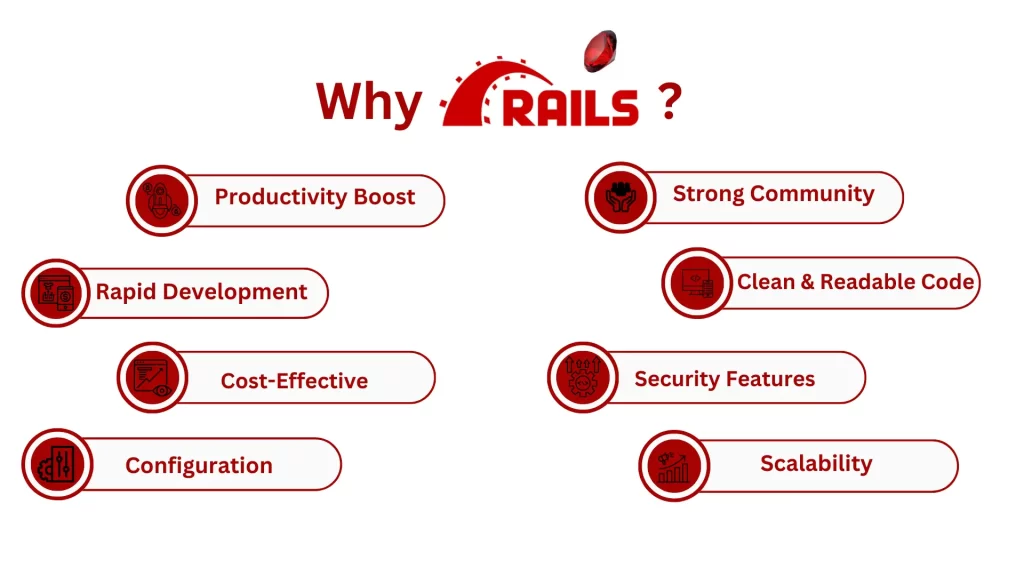
Developers often choose Ruby on Rails for its productivity, speed of development, clean code practices, strong community support, scalability, conventions, security features, and cost-effectiveness. These factors make it a versatile and reliable framework for building a variety of web applications.
Advantages of Ruby on Rails
Advantages include developer productivity, scalability, a vibrant community, and a vast ecosystem of plugins and libraries. Rails’ convention over configuration reduces the amount of code developers need to write, speeding up the development process.
Developer Happiness and Satisfaction: One distinctive advantage of Ruby on Rails is its emphasis on optimizing for developer happiness. The framework prioritizes creating an enjoyable and fulfilling experience for developers throughout the development process. This focus on developer satisfaction can have profound effects on productivity, creativity, and the overall success of a project.
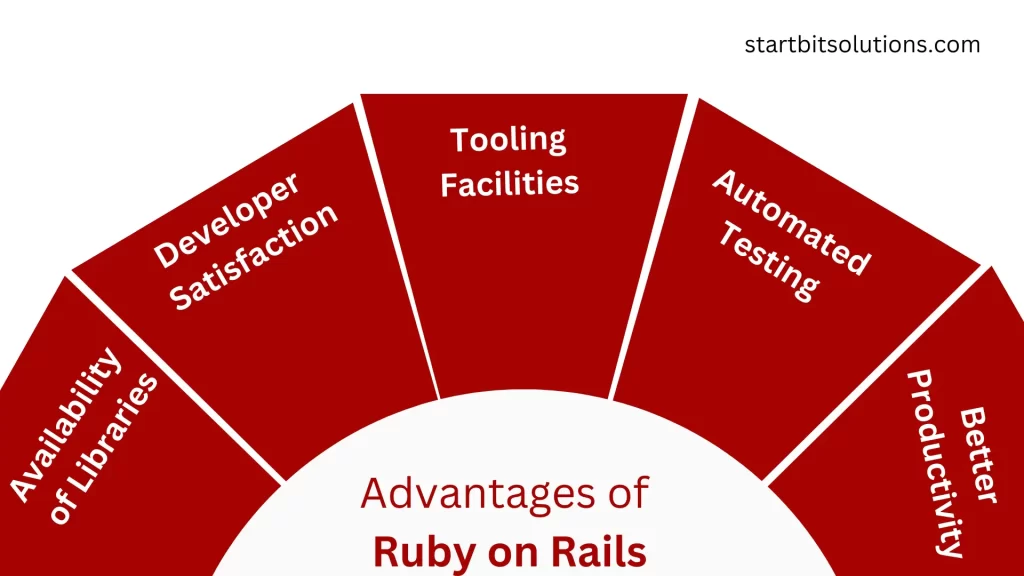
Here’s why this matters:
- Joyful Coding Experience: Ruby on Rails is designed to minimize the mundane and repetitive tasks that developers often face. By providing elegant and readable syntax, along with conventions that reduce decision fatigue, developers can focus more on the creative aspects of coding rather than boilerplate configurations.
- High Retention of Skilled Developers: A framework that prioritizes developer happiness is more likely to retain skilled professionals. Happy developers are not only more productive but also contribute positively to the team’s dynamics and collaboration. This can lead to lower turnover rates and increased expertise within a development team.
- Innovation and Creativity: When developers enjoy the process of coding, they are more likely to explore innovative solutions and think creatively about problem-solving. Ruby on Rails’ commitment to developer happiness can foster an environment that encourages experimentation and the pursuit of elegant solutions.
- Positive Impact on Mental Health: The demanding nature of software development can sometimes lead to burnout and stress. Ruby on Rails’ focus on making development enjoyable can contribute to a healthier work environment, positively impacting the mental well-being of developers.
- Community Building: A framework that values developer happiness tends to attract a community of like-minded individuals who share a passion for coding and problem-solving. This positive community culture can lead to increased knowledge sharing, collaboration, and the overall growth of the developer community.
Availability of Libraries: Ruby on Rails benefits from a rich ecosystem of libraries and gems. The availability of these pre-built components simplifies development, allowing developers to leverage existing solutions for common functionalities. This not only speeds up development but also ensures the use of well-tested and reliable code.
Best Tooling Facilities: Ruby on Rails provides comprehensive tooling facilities that enhance the development experience. From robust debugging tools to efficient code generators, the framework offers a set of integrated tools that contribute to a smooth and streamlined development process. This comprehensive tooling minimizes friction in the development workflow.
Enables Automated Testing: Automated testing is a fundamental aspect of Ruby on Rails. The framework encourages and facilitates the implementation of automated tests through tools like RSpec and Minitest. This focus on testing contributes to the creation of more reliable and maintainable code, reducing the likelihood of bugs and enhancing the overall quality of the software.
Better Productivity: Ruby on Rails’ emphasis on convention over configuration, coupled with its modular design and comprehensive tooling, results in a development environment that enhances productivity. Developers can build features quickly, and the framework’s conventions reduce the need for repetitive boilerplate code. This leads to faster development cycles and efficient use of resources.
Disadvantages of Ruby on Rails
Some drawbacks include performance concerns compared to other languages/frameworks, a learning curve for beginners, and potential issues with scaling for extremely large applications.
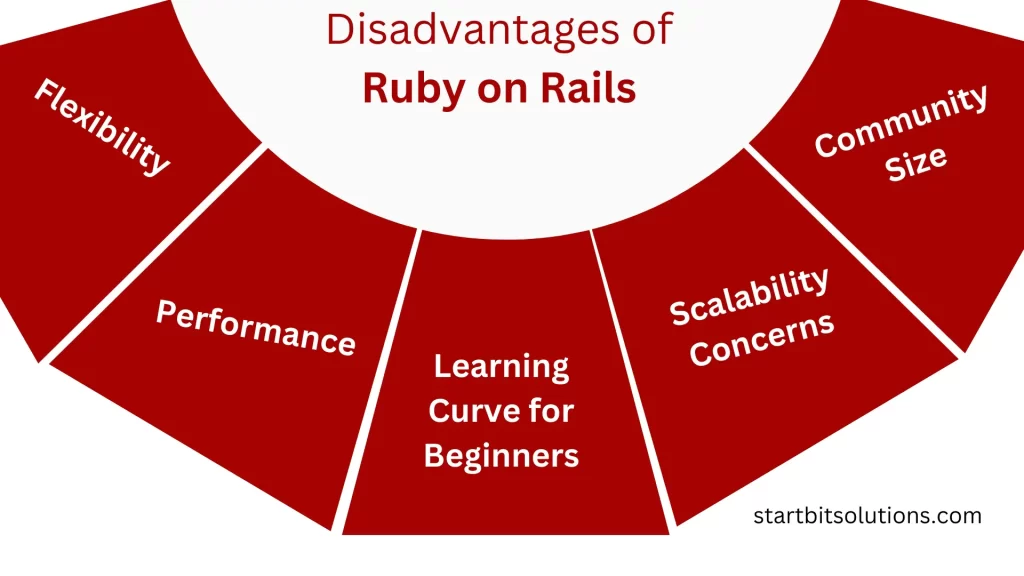
Learning Curve for Beginners: For developers new to web development or those coming from different programming backgrounds, Ruby on Rails may have a steeper learning curve. The conventions and magic behind the framework might be confusing initially.
Performance: Compared to some other web frameworks, Ruby on Rails may not be as performant in certain scenarios. It might not be the best choice for extremely high-performance applications or projects that demand low-level optimization.
Scalability Concerns: While Ruby on Rails can handle moderate to large-scale applications, it may face scalability challenges for extremely high-traffic or resource-intensive applications. Ensuring scalability may require additional effort and optimization.
Community Size: While the Ruby on Rails community is active and supportive, it is not as extensive as some other frameworks like JavaScript-based ones. This could impact the availability of resources, plugins, and third-party libraries.
Concurrency and Multithreading: Ruby on Rails traditionally has challenges with concurrency and multithreading. While there have been improvements, it may not be the best choice for applications that require high levels of concurrent processing.
Flexibility vs. Convention: While convention over configuration is a strength, it might be a limitation for developers who prefer more flexibility and customization. Some developers may find it restrictive when they need to deviate from Rails’ conventions.
Future of Ruby on Rails
Ruby on Rails continues to be a popular choice among developers due to its elegant syntax and convention over configuration principle. With a significant user base and a plethora of successful applications, it stands as a testament to its efficiency and effectiveness.
Despite facing competition from other frameworks, Ruby on Rails maintains a strong position, especially in startups and small to medium-sized businesses. Its ease of use and rapid development capabilities make it an attractive option for projects with tight deadlines.
The future of Ruby on Rails remains bright. With a strong community, adaptability to emerging technologies, and a track record of successful applications, Ruby on Rails is poised to continue thriving in the world of web development.
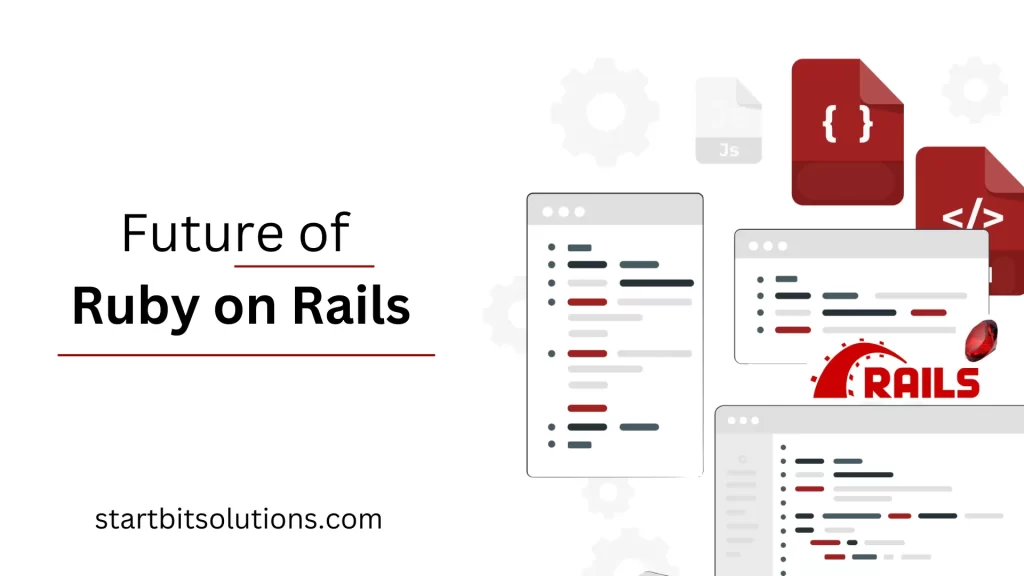
Startbit IT Solutions Ruby and Rails Development Company :
Discover the efficiency and power of Ruby on Rails with Startbit, your trusted development partner. With over 14 years of dedicated experience in RoR web and mobile development, we bring a wealth of knowledge and expertise to accelerate your enterprise software projects.
Ruby on Rails is not just a framework; it’s a community-driven powerhouse that facilitates agile and cost-effective custom software development. Our commitment to the open-source nature of RoR ensures that your applications are not only robust and dynamic but also benefit from a vast array of pre-existing code, making development faster and more seamless.
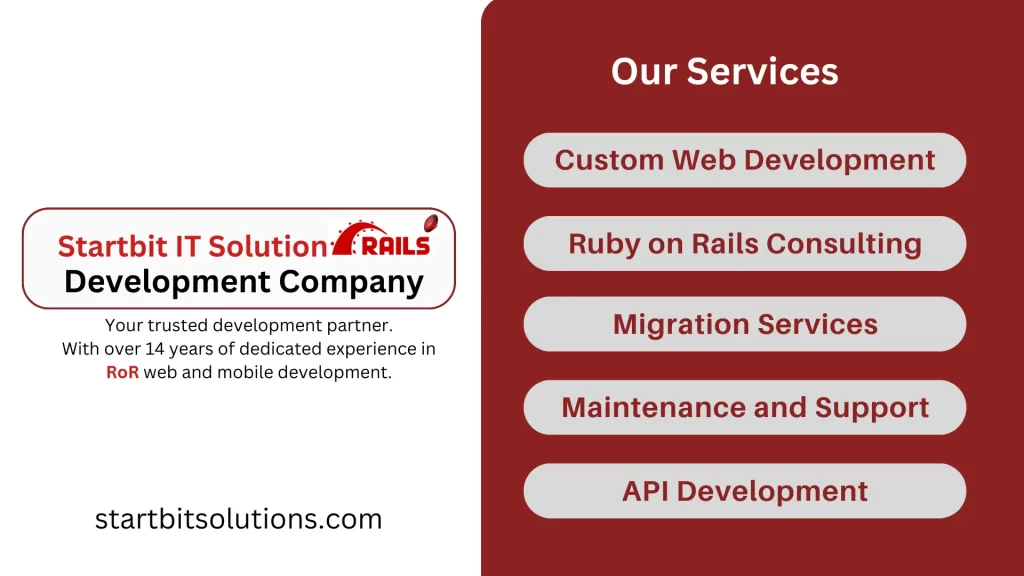
Our Services:
- Custom Web Development: Tailored solutions to meet your specific business requirements.
- Ruby on Rails Consulting: Expert advice on architecture, scalability, and best practices.
- Migration Services: Seamless migration from legacy systems to Ruby on Rails.
- Maintenance and Support: Ongoing support to keep your applications running smoothly.
- API Development: Building robust APIs for seamless integration with other services.
Why Startbit IT Solutions?
- Proven Track Record: We have successfully delivered projects across various industries.
- Dedicated Team: Our team is committed to providing top-notch development services.
- Client-Centric Approach: We prioritize understanding your business goals to deliver the best solutions.
- Agile Development: We follow agile methodologies for faster and more adaptive development.
- Transparent Communication: Regular updates and open communication throughout the development process.
Global Reach, Local Commitment
While based in the US, we extend our services worldwide, including clients in New Zealand, Australia, and South Africa. At Startbit, we value effective communication, transcending time zones effortlessly. Utilizing tools like Skype, Google+ Hangouts, Trello, and more, we ensure clarity in our collaboration.
Contact Us:
Ready to embark on your Ruby on Rails development journey? Get in touch with Startbit IT Solutions today, and let’s turn your ideas into reality.
Directly contact us: Contact Us
By Email for any query on product discussion: info@startbitsolutions.com
A: Ruby is a dynamic, object-oriented programming language known for its simplicity and productivity.
A: Yukihiro “Matz” Matsumoto created Ruby in 1995.
A: As of my last update in 2022, the latest version was Ruby 3.0.
A: Use # for single-line comments and =begin and =end for multiline comments.
A: A Ruby gem is a packaged Ruby application or library.
A: Ruby on Rails, or Rails, is a web application framework written in Ruby.
Ans: David Heinemeier Hansson released Ruby on Rails in 2004.
A: As of my last update, it was Rails 6.1.
A: MVC stands for Model-View-Controller. It separates the application into three interconnected components to manage complexity.
A: A scaffold is a code generator that creates a full set of controllers, models, views, and database migration for a model.
A: Use rails db:migrate.
A: ActiveRecord is Rails’ Object-Relational Mapping (ORM) system for database interactions.
A:The comparison between Ruby and Python depends on specific use cases and personal preferences. Both languages are powerful and have extensive libraries and frameworks. Ruby is often associated with web development, especially through Ruby on Rails, while Python is recognized for its versatility in various domains, including web development, data science, machine learning, and scripting. The choice between Ruby and Python depends on factors such as project requirements, community support, and developer familiarity.
A: Ruby on Rails is primarily written in the Ruby programming language. Ruby is known for its elegant syntax, flexibility, and readability, making it a suitable language for developing web applications.
A: Ruby on Rails is a backend framework. It facilitates the development of server-side logic, manages databases, and handles the business logic of web applications. While it primarily deals with the backend, Rails can also be used in conjunction with front-end technologies like HTML, CSS, and JavaScript to create full-stack web applications.
Q: What is Ruby on Rails development?
A: Ruby on Rails, often referred to as Rails, is a web application framework written in the Ruby programming language. It follows the Model-View-Controller (MVC) architectural pattern and provides a set of conventions for building robust and maintainable web applications. Ruby on Rails emphasizes convention over configuration, allowing developers to write less code and focus on best practices.


